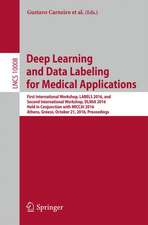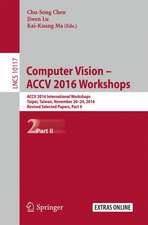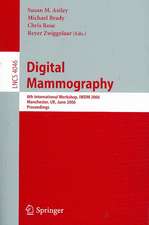A Taxonomy for Texture Description and Identification: Springer Series in Perception Engineering
Autor A. Ravishankar Raoen Limba Engleză Paperback – iul 2012
Preț: 328.79 lei
Preț vechi: 410.98 lei
-20% Nou
Puncte Express: 493
Preț estimativ în valută:
62.92€ • 67.28$ • 52.46£
62.92€ • 67.28$ • 52.46£
Carte tipărită la comandă
Livrare economică 18 aprilie-02 mai
Preluare comenzi: 021 569.72.76
Specificații
ISBN-13: 9781461397793
ISBN-10: 1461397790
Pagini: 224
Ilustrații: XXIII, 198 p.
Dimensiuni: 155 x 235 x 12 mm
Greutate: 0.32 kg
Ediția:Softcover reprint of the original 1st ed. 1990
Editura: Springer
Colecția Springer
Seria Springer Series in Perception Engineering
Locul publicării:New York, NY, United States
ISBN-10: 1461397790
Pagini: 224
Ilustrații: XXIII, 198 p.
Dimensiuni: 155 x 235 x 12 mm
Greutate: 0.32 kg
Ediția:Softcover reprint of the original 1st ed. 1990
Editura: Springer
Colecția Springer
Seria Springer Series in Perception Engineering
Locul publicării:New York, NY, United States
Public țintă
ResearchCuprins
1 Introduction.- 1.1 Scope of the book.- 1.2 Importance of texture.- 1.3 Potential applications of this research.- 1.4 Issues in automated process control involving computer vision.- 1.5 A taxonomy for texture.- 1.6 Outline.- 2 Computing oriented texture fields.- 2.1 Introduction.- 2.2 Background.- 2.3 Oriented Texture Fields.- 2.4 Experimental Methods.- 2.5 Experimental Results.- 2.6 Analyzing texture at different scales.- 2.7 Processing of the intrinsic images.- 2.8 Conclusions.- 3 The analysis of oriented textures through phase portraits.- 3.1 Introduction.- 3.2 Background.- 3.3 Geometric theory of differential equations.- 3.4 Experimental Methods.- 3.5 Experimental Results.- 3.6 Experiments with noise addition.- 3.7 A related model from fluid flow analysis.- 3.8 Discussion.- 3.9 Conclusion.- 4 Analyzing strongly ordered textures.- 4.1 Introduction.- 4.2 Extraction of primitives.- 4.3 Extracting structure from primitives.- 4.4 Models for strongly ordered textures.- 4.5 Symbolic descriptions: models from petrography.- 4.6 Frieze groups and wallpaper groups.- 4.7 Implications for computer vision.- 4.8 Summary.- 5 Disordered textures.- 5.1 Statistical measures for disordered textures.- 5.2 Describing disordered textures by means of the fractal dimension.- 5.3 Computing the fractal dimension.- 5.4 Experimental Results.- 5.5 Conclusion.- 6 Compositional textures.- 6.1 Introduction.- 6.2 Primitive textures.- 6.3 A Parametrized symbol set.- 6.4 Three types of composition.- 6.5 Linear combination (transparent overlap).- 6.6 Functional composition.- 6.7 Opaque overlap.- 6.8 Definition of texture.- 6.9 A complete taxonomy for texture.- 6.10 Implementing the taxonomy.- 6.11 Conclusion.- 7 Conclusion.- 7.1 Summary of results.- 7.2 Contributions.- 7.3 Future Work.- B Region Refinement.- C Preparation of the manuscript.- Permissions.































